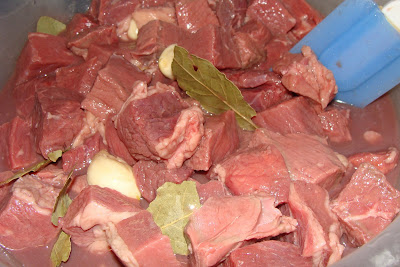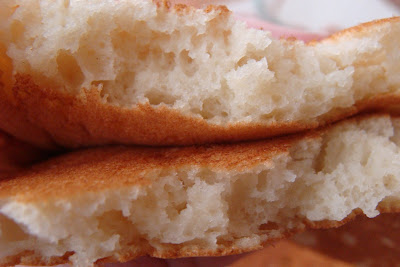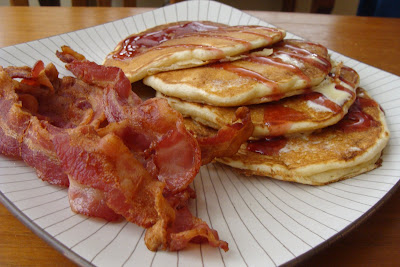

I’m still cooking meals for the new parents. I wanted to make something that reheats well and tastes better as it sits and the flavors meld together. I was talking to a co-worker and she swore by the Barefoot
Contessa’s beef stew recipe. She said the recipe is called “Parker’s Beef Stew” but there are two variations of the same recipe out there. The recipe currently posted on the food network is the inferior recipe. She said the “good” recipe had bacon.
I searched and I searched and I found it online. I'm the google queen. When I got home I also found the recipe in my Barefoot
Contessa Back to Basics cookbook. This is what I don’t like about Ina
Garten’s recipes. She publishes several versions of the same recipe. You make something and then you go back to find the recipe again and it has morphed. I realize she probably alters it as the recipe evolves but she should make sure that the recipe posted on a site like the food network is the most recent recipe.
My co-worker gave me a few tips for making this recipe. She said she only uses enough wine to cover the beef. The recipe calls for an entire bottle for the marinade and then to discard all but 2 ½ cups. Why waste good wine? My co-worker also said to use less wine (just over a cup of the 2 ½ cups Ina calls for) or else the wine flavor will be too overpowering. I also read a few reviews about the wine flavor. I doubled the recipe and I only used about 2 ½ cups wine to cover the 5 pounds of beef.
I found the recipe a little flawed or at least a little harder to successfully orchestrate. The recipe may make sense to a seasoned cook but can be a recipe for failure for an amateur. This recipe was not written for "Beef Stew for Dummies." I read many reviews on the food network. The recipe posted was the inferior recipe but it was very close to the newer improved recipe. There shouldn't be so many varying ratings. Many people raved about the recipe and said it was the best beef stew recipe ever. Many people also rated it 1 star and said they tried eating it but ended up tossing the entire pot of very expensive stew. I'm posting the original recipe as written and then I am posting what I did. I think recipe itself is pretty good with some minor changes and
interpretation. I did double the recipe and some of method changes were due to pot and pan constraints.
Five pounds of bottom round steak. Ina said to use a chuck but the bottom round steak was on sale and it is suitable for stew. I left some of the fat on the cubes because it helps with the browning and the flavor. However, I did remove the sinewy pieces.

PARKER’S BEEF STEW
Ina's favorite winter dish is easy to reheat and tastes even better the next day!
Serves 6
2 1/2 pounds good-quality chuck beef, cut into 1 1/4-inch cubes
1(750 ml bottle) good red wine, such as Cabernet
Sauvignon3 whole garlic cloves, smashed
3 bay leaves
6 ounces bacon, cut in 1-inch pieces
All-purpose flour
Kosher salt
Freshly ground black pepper
Good olive oil
2 cups chopped yellow onions
2 tablespoons minced garlic (4 cloves)
1 pound carrots, peeled and cut diagonally in 1 1/2-inch chunks
1 pound small potatoes, halved or quartered
1 (14 1/2 ounce can) beef stock
1 large (2 small) branch fresh rosemary
1/2 cup sun-dried tomatoes in oil, drained and sliced
2 tablespoons Worcestershire sauce
1 (10-ounce) package frozen peas (not
petits pois)
1. Place the beef in a bowl with the red wine (I use a good one since it’s an important flavor), whole garlic, and bay leaves. Place in the refrigerator and allow to marinate overnight.
2. The next day, preheat the oven to 300˚F.
3. Brown the bacon in a large (12-inch)
sauté pan for 5 to 7 minutes, over medium-low heat. With a slotted spoon, transfer the bacon to a Dutch oven, such as Le
Creuset. Combine 2 cups of flour, 1 tablespoon salt, and 1 tablespoon pepper. Lift the beef out of the marinade and discard the bay leaves and garlic, saving the marinade. In batches, dredge the cubes of beef in the flour mixture and then shake off the excess. In the
sauté pan, brown half the beef over medium heat for 5 to 7 minutes, turning to brown evenly. Place the beef in the Dutch oven with the bacon and continue to brown the remaining beef, placing it all in the Dutch oven.
4. Lower the heat to medium-low, add the onions to the
sauté pan, and cook for 5 minutes. Add the minced garlic and cook for 1 more minute. Add the carrots and potatoes and cook for 5 more minutes, stirring occasionally.
Place all the vegetables in the Dutch oven with the beef. Add 2 1/2 cups of the reserved marinade (discard the rest) to the
sauté pan and cook over high heat to
deglaze the bottom of the pan, scraping up all the brown bits with a wooden spoon. Add the beef stock, rosemary, sun-dried tomatoes, Worcestershire sauce, 1 tablespoon salt, and 2 teaspoons pepper. Pour the sauce over the meat and vegetables in the Dutch oven and bring it to a simmer over medium heat on top of the stove. Cover the pot and place it in the oven for 2 hours, until the meat and vegetables are all tender, stirring once during cooking. If the stew is boiling rather than simmering, lower the heat to 250˚F or 275˚F.
5. When the stew is done and the meat is tender, whisk 2 tablespoons of flour and 1 cup of the sauce together and pour it back into the stew. Simmer for 3 minutes, until thickened. Stir in the frozen peas, season to taste, and serve hot.
Malisa's Take on Parker's Beef Stewserves 125 pounds good-quality boneless bottom round beef, cut into 1 inch cubes
2 1/2 cups good red wine,
(I used a Pinot Noir.)6 whole garlic cloves, smashed
6 bay leaves
Rendered bacon fat, as needed
(I didn't think it was necessary to actually cook up some bacon since it will disintegrate into the stew. I already have a reserve of rendered bacon and duck fat in the fridge.)1 cup all-purpose flour
Sea salt, to taste
Freshly ground black pepper
4 cups chopped yellow onions
4 tablespoons minced garlic (8 cloves)
2 pounds carrots, peeled and cut diagonally in 1 1/2-inch chunks
2 pounds small potatoes, halved or quartered
(I used rose gold potatoes. The skins are red but they act just like a yukon gold.)2 (14 1/2 ounce can) beef stock
2 teaspoon dried rosemary
1 teaspoon dried thyme
1 cup sun-dried tomatoes in oil, drained and sliced
4 tablespoons Worcestershire sauce
2 (12-ounce) package frozen peas (not
petits pois)
1. Place the beef in a bowl with the red wine, smashed garlic, and bay leaves. Place in the refrigerator and allow to marinate overnight.
(I marinated the beef almost 24 hours because of my schedule.)
Cubes of beef marinating in pinot noir, bay leaves, and garlic. The beef smelled really good after sitting in the marinade for almost 24 hours.

2. The next day, preheat the oven to 300˚F.
3. Strain the beef and reserve the marinade.
(I did this immediately when I got home and changed. This is important because I read that by lifting the beef cubes out of the marinade into the seasoned flour, as instructed by Ina, the beef was coated with too much flour resulting in a too thick stew and the liquid in the beef made it difficult to brown.)4. Add bacon fat to a heated cast iron dutch oven.
5. Combine 1 cup of flour with 1 teaspoon of salt and 1 teaspoon of pepper.
6. Dredge the strained beef cubes in the seasoned flour and brown the beef in batches. Discard the bay leaves and garlic. Place the browned beef in a large bowl.
(The original recipe called for 2 cups of flour, 1 tablespoon of kosher salt, and 1 tablespoon of black pepper. Many people complained that the recipe was too salty, too peppery, and too thick. I don't think Ina intended the entire 2 cups (in my case it would be 4 cups) be used for the dredging. When you dredge, you usually have more flour in the bowl but you don't use it all. Also there is a difference between kosher salt and finer grain table salt. I am currently using a finer grain sea salt so I adjust my recipes accordingly.) 7. When done browning the last batch of beef, return the previous batches to the dutch oven. Add the marinade to
deglaze. Using a wooden spoon, scrape up all the brown bits on the bottom of the dutch oven. Bring to a boil, add the beef broth, allow to come back to boil and reduce to a simmer.
8. Meanwhile in a separate pan on medium heat, saute the potatoes in rendered bacon fat. Cook about 5 minutes or until slightly golden. Transfer potatoes to a large bowl. Saute the carrots in rendered bacon fat about 5 minutes. Transfer to the large bowl with the potatoes. Saute onions in bacon fat about 3 minutes, add minced garlic and saute about 1 minute longer. Transfer onions and garlic to bowl with potatoes and carrots. Stir to mix.
(I did this in a separate pan instead of the same pan as the beef because I wanted the beef to get a head start with the simmering. I also had to cook the veggies in batches since I doubled the recipe.)9. Add rosemary, thyme, sun-dried tomatoes, salt, pepper, and
Worcestershire sauce to simmering beef. Simmer the beef about 45 minutes.
(There are two reasons why I decided to braise on the stovetop for 45 minutes. The first reason is to make sure the alcohol cooks off. The second reason is because I didn't want the vegetables to get mushy with the long oven braising. Many people said that the simmering helps with the over-powering wine flavor. Some people also said the vegetables virtually disintegrate after two hours of oven braising.) 10. Divide the sauteed vegetables between two dutch ovens, two covered casseroles, or any combination of oven-proof covered cooking vessels. Divide the simmered beef and liquid between the vessels. Stir to combine the vegetables and beef. Cover and braise in oven for about 1 1/2 hours.
(You can also braise at a lower temp for a longer time.)This is after the combining and before the oven braising.

11. While the stew is braising, toast the leftover dredging flour. You can do this in the oven or on the
stovetop. This is just in case you may need more flour to thicken the stew. By toasting the flour, you will get rid of the "raw" flour taste. When the stew is done and if it needs a little more thickening, whisk the toasted flour with some of the stew liquid and mix it in the stew. Return it back to the oven and braise a few minutes more.
(I didn't make a roux because there was enough fat already in the pot and I didn't want to add any more. Many people complained that the stew was too oily. They probably used a lot of fat to brown the meat and vegetables. Ina suggests whisking 2 tablespoons of flour with 1 cup of the stew liquid and pouring it back in the stew. I don't like this method. You can use cornstarch or arrowroot as a last minute thickener but cornstarch will break down and lose its thickening power in about 10 minutes of cooking.)12. When stew is done, taste, adjust seasonings, and add the frozen peas.
(Ina gave amounts for salt and pepper in her recipe. I don't usually like to unless it is a baking formula. Many people complain that the recipe was too salty and too peppery. I think they added all the dredging flour to the pot and/or they used table salt while Ina calls for kosher salt. I tend to under-salt my food since I have a pretty sensitive palate. Maybe as I get older, my taste buds will start to die off and I will need to be a little heavy-handed on the salt.)After 1 1/2 hours of oven-braising, the meat was tender but the veggies were not mushy.

I actually don't know how the stew tastes. I don't eat beef or at least beef when it resembles beef. Everyone said it was delicious.

































































